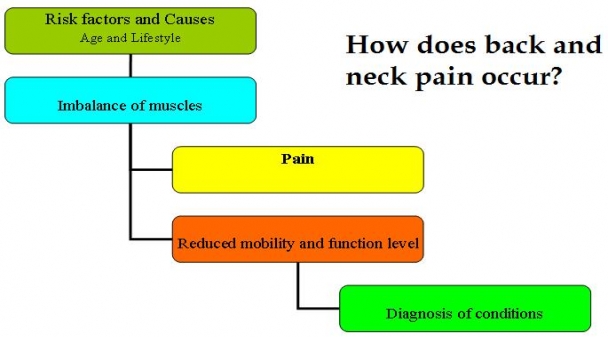Call us on 02 9818 6660


Your back is a complex structure of bones, ligaments, muscles, tendons and nerves. (Refer to diagram, right)
The back bone is made up of vertebrae, bones which protect the spinal cord. Ligaments and muscles are tissues that provide support but may also be torn and weakened. Discs are located between vertebrae and act as shock absorbers. These can wear down, rupture or bulge out.
The nerves, carry messages through the spinal cord from the organs in the body to and from the brain. These may get pinched, stretched and irritated.
Back pain may occur suddenly (acute pain) or develop slowly and persist for more than three months (chronic pain).
Chronic back pain is estimated to affect 80% of world’s population. Your back is very vulnerable! Many people do not think about it until they have back pain. Your osteopath will provide relaxing and pleasant techniques to manage your neck and back pain.

Back pain can be caused by: ruptured discs, muscular tension, spasm, sport injuries, poor posture, emotional stress, kidney stones, and presence of underlying conditions: pregnancy, arthritis, urinary infection
Back pain (also referred to as dorsopathy) can occur in any area of the back and range in types and severity of pain. The pain can be dull, sharp, and may seem doing a simple task is a huge effort. Some people may not even be able to do a simple task due to severe back pain. The pain may also be localised or radiate to other parts of the body.
The type of pain may range from: tight, stiff, pulling, tingling, shooting down the leg. Person may feel warm or cool sensations. When the nerve is compressed person may feel numb and weak in the muscle, pinched nerve results in stabbing or burning pain.
Other symptoms may include: difficulty passing urine, loss of balance when standing

The neck consists of seven vertebrae, referred to as cervical vertebrae C1 - C7. Some symptoms may include: stiffness, soreness, cramps and tightness.
Neck pain can be caused by: cervical muscle strain, stress, muscle tension, poor sleep posture, Osteopaths can treat chronic or acute pain and treat to prevent pain recurring.
Osteopathy takes on the holistic approach when planning the treatment plan, obtaining information about your lifestyle (diet, exercise and work) and underlying conditions with aim to minimise and prevent back pain.

To effectively manage back pain, the osteopath may use manipulation.
Manipulation is hands on and means the therapeutic application of manual pressure.
This is where the osteopath uses their hands to examine the spine and nearby muscles, or pain and restriction during motion that could signal an injury or impaired function.
There are several techniques of manipulation:
The Osteopath can also use other techniques such as low level laser or acupuncture to manage your pain. Osteopaths will also be able to advise you with strategies that are effective and suitable to your lifestyle and condition. This may involve stretching, exercises, diet, correct posture to maximise your health and quality of life.
An important element in back pain management and prevention of its reoccurrence is the understanding how back pain occurs. Refer to diagram below. It is important to note that your osteopath will begin to assess your back pain at the initial level and progressing throughout all the steps. The management of the condition will not only focus on eliminating pain and diagnosis but correcting the problem starting with imbalance of muscles.
